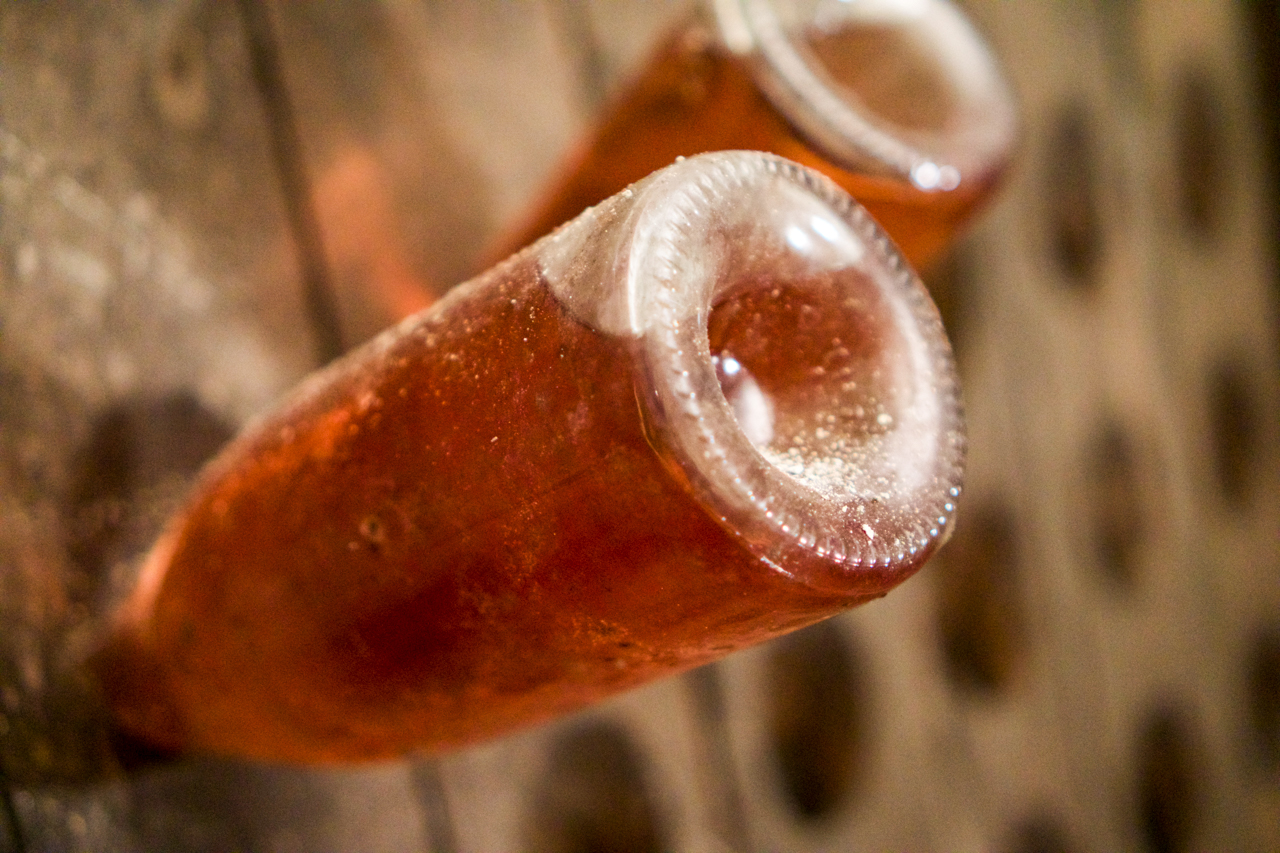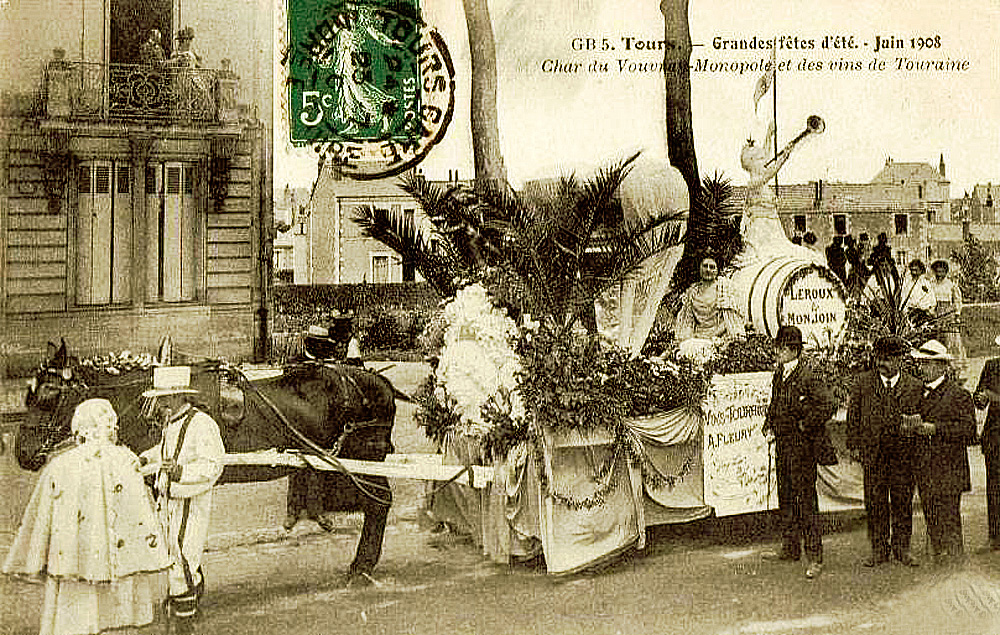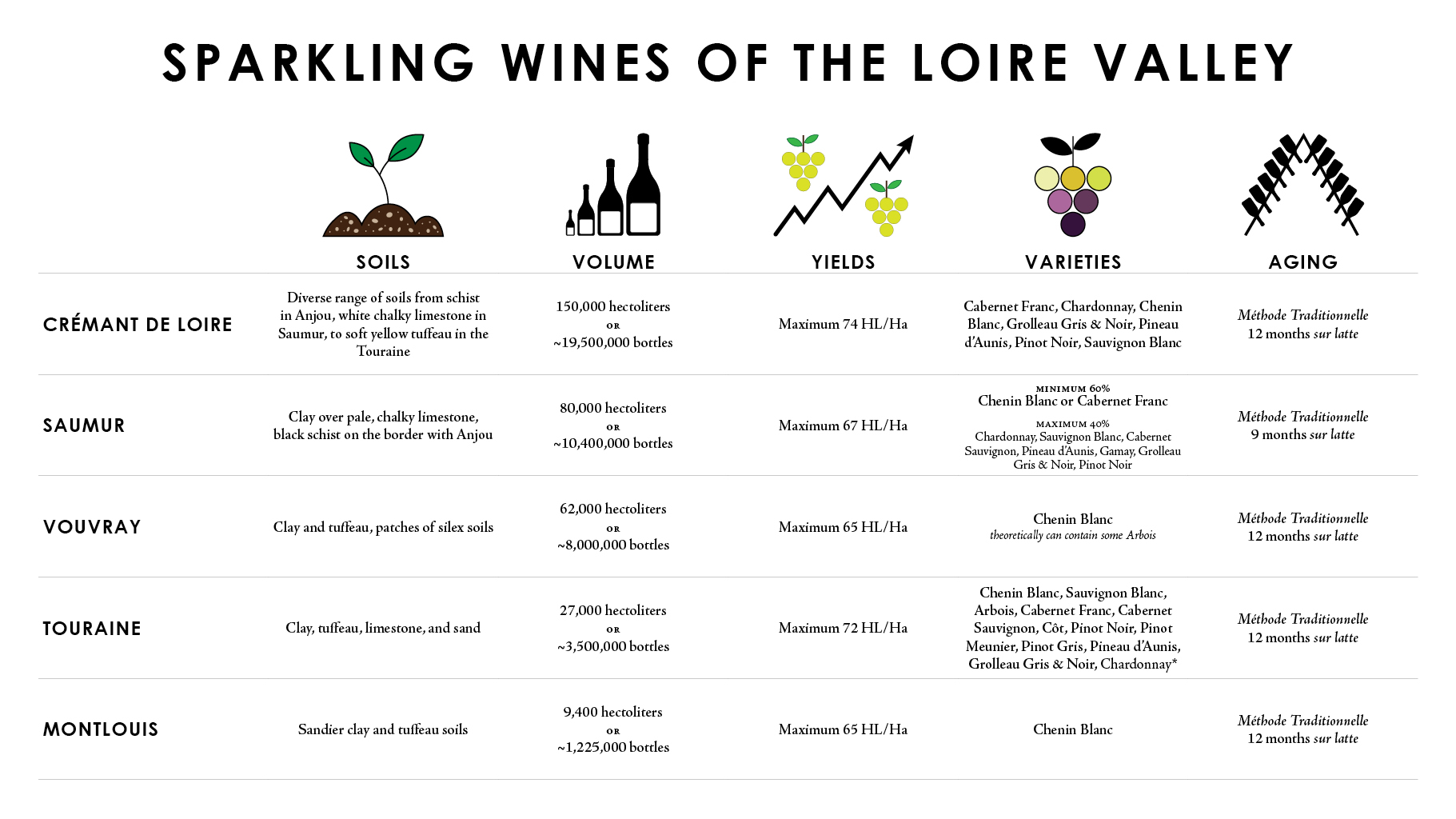

By Steven Spanbauer
Unlike Limoux or Champagne, the Loire Valley doesn’t have a centuries-old tradition of sparkling wine production. Yet, in France’s annual volume of sparkling wine production, it is second behind Champagne. The quantity of hand-made bubbles represents a small percentage of total production, so we recommend sticking to those names you recognize as solid growers in their appellations or bubbles from trusted importers. Here are the basic facts on the most common sparkling appellations in the Loire.

Crémant de Loire was established in 1975 as a catch-all category of sparkling wine made in the Anjou, Saumur & Touraine. This appellation has the widest range of terroirs from the black schist of Anjou, the harder chalkier limestone of Saumur, to the soft, yellow limestone of the Touraine. Total production is close to 150,000 HL of wine, making it the largest sparkling wine designation in the Loire. To be called Crémant de Loire, the wines must have a secondary fermentation in bottle, Méthode Traditionnelle, and be aged at least 12 months sur latte. The strength of Crémant de Loire is its recognition of a diversity of terroir and varieties. Permitted varieties include Cabernet Franc, Chardonnay, Chenin Blanc, Grolleau Gris & Noir, Pineau d’Aunis, Pinot Noir, and Sauvignon Blanc. Because of this flexibility, you will find the most interesting and most humdrum sparkling wines carrying this designation.

Château de Saumur and the caverns beneath the town of Saumur.
Sparkling Saumur is the original sparkling wine of the Loire Valley, dating back to the 1830s. The town of Saumur is surrounded by vines and built over a warren of caves, making it the Reims of the Loire. It should come as no surprise then that as the market for Champagne exploded in the 19th century, Saumur would be carried along with this new thirst for bubbles. An oddity of this appellation is that it corresponds to the old provincial boundaries of Saumur. Hence, while it is centered on a heartland of pale, hard, chalky limestone, it also includes along its western edge a portion of Anjou with black schist soils. To carry the Sparkling Saumur name, the wine must be made from a minimum of 60% Chenin Blanc or Cabernet Franc, followed by a secondary fermentation in the bottle, and aged at least 9 months sur latte. The other permitted varieties must be less than 40% of the blend and include, Chardonnay, Sauvignon Blanc, Cabernet Sauvignon, Pineau d’Aunis, Gamay, Grolleau Gris & Noir, and Pinot Noir. Total production of Saumur Sparkling is just shy of 80,000 HL per year, making this appellation the second largest in the Loire. One of the few remaining family-controlled operations in Saumur is Louis de Grenelle. Their range of sparkling wines is bottled either as Crémant, Saumur, or Vin de France based on their blends. Corail, which is 100% Cabernet Franc is a classic Saumur Sparkling while their Bellay is 100% Chardonnay and therefore a Crémant de Loire.

I guarantee that this party was fueled by sparkling Vouvray
A surprising bronze medal winner is Vouvray which produces 62,000 HL of sparkling wine per year. There is probably no greater dichotomy between a great bottle of still Vouvray and the average Sparkling Vouvray, so it is paramount to stick with the most trusted names as these can be both sublime and age-worthy. Like Saumur, Vouvray sits over a warren of caves quarried to build the houses and castles above ground. These caves are not only perfect for aging still wines but are ideal for sparkling wine production. Unlike the more permissive regulations in Crémant de Loire and Saumur, sparkling Vouvray must be made from Chenin Blanc. Sparkling Vouvray is a Méthode Traditionnelle wine that must be aged at least 12 months sur latte. Many quality-focused growers, like Domaine du Viking, age it much longer.
At 27,000 HL per year, Touraine is significantly behind Vouvray in terms of production. With looser regulations, a mix of terroirs from sandier soils to chalky limestone, a greater latitude of styles is present in the Touraine. Being a geographically large region (from St-Nicolas de Bourgueil and Chinon in the west to Cheverny in the East) and with lower production, many growers lavish far more attention on these wines than your average Saumur or Crémant. Still, it pays to seek out family estates and those with an established reputation. In addition to the permitted varieties in the Touraine: Chenin Blanc, Sauvignon Blanc, Arbois, Cabernet Franc, Cabernet Sauvignon, Côt, Pinot Noir, Pinot Meunier, Pinot Gris, Pineau d’Aunis, Grolleau Gris & Noir, the sparkling wines of Touraine can also include up to 20% Chardonnay in their blend. These wines must spend at least 12 months sur latte, although the best growers age them longer.
Long in the shadow of Vouvray, and at one point part of this more known neighboring appellation, Montlouis has begun to emerge from the shadow of Vouvray. While the soils are generally sandier and the countryside lacks the dramatic hillsides fronting the Loire with perfect orientation and soils, the top sites in Montlouis can make wines that rival all of Vouvray except the most famous vineyards and top growers. With less expensive vines than Vouvray, it has become a hotbed of innovative and creative winemakers. Its production of sparkling wines is among the lowest at 9400 HL per year. Any sparkling wine from a young vigneron in Montlouis is probably worth trying as it will be more engaging than more than 90% of Vouvray Brut. Montlouis follows the same general guidelines as Vouvray in that the wines must be made from 100% Chenin Blanc, with a secondary fermentation in bottle and at least 12 months sur latte. Montlouis also recognizes another type of sparkling wine, Pétillant Originel. This wine is only made by a few growers and is, in essence, a cross between a Pet-Nat and a wine aged sur latte. No sugar or yeast can be added to these wines, so they are bottled when the primary fermentation is winding down (Méthode Ancestrale), then aged for at least 9 months sur latte before disgorgement. These are exacting standards that ensure stable, naturally fizzy wines between 1-2.5 atmospheres. Xavier Weisskopf makes an example of this style of Pétillant Originel.

This is our best attempt at placing all the details on the most popular sparkling appellations in the Loire Valley in one place. Click for a PDF you can download.
Some additional details about bubbly wines from the Loire are included below.
Pet-Nat is a category of wines bottled before the primary fermentation is completed. Hence, the resulting wine usually contains some sediment (there is a lively debate over disgorgement in this group) and varying amounts of residual sugar. As of yet, there are no regulations regarding these Méthode Ancestrale wines. Some of us are old enough – I’m looking at you, JD – to remember the days before their current fame when these wines were shared during the wintertime wine expos in the Loire Valley, and their friendly, quaffable nature fueled many late-night misadventures. You never quite know what you’re going to get with a Pet-Nat, which is part of their charm but if you like more predictable results when you pull a cork (or when the cork sails with reckless abandon across the room along with a not-insignificant portion of the wine in the bottle), you might be better served sticking to more formalized appellations from dependable growers.
Pétillant is a designation for sparkling wines between 1 and 2.5 atmospheres, while those wines above 3 atmospheres can have various indications on their label, including Sparkling, Méthode Traditionnelle, Brut, or Mousseaux. Demi-Sec and Doux indicate that there is noticeable residual sugar in the wine most notably used in Vouvray and Montlouis, although this is becoming less common in wines imported into the US as tastes move towards a preference for drier styles of wine.
Some more experimental or avant-garde wines fall outside the rules and are bottled simply as Sparkling Rosé, such as Si Irrésistible, made solely from Grolleau Gris & Noir. There are some smaller appellations we’ve omitted in the Anjou, namely Anjou Mousseaux and Pétillant (4100HL total production), and Rosé d’Anjou Pétillant, an appellation of minuscule production. We’d be remiss if we didn’t also take note that the love of bubbles has spread to the Pays Nantais. However, these wines have yet to be regulated by the AOC in the region. Our friend, Jo Landron, bearer of one of the most spectacular Gallic mustaches, makes one of the finest – Atmosphères.